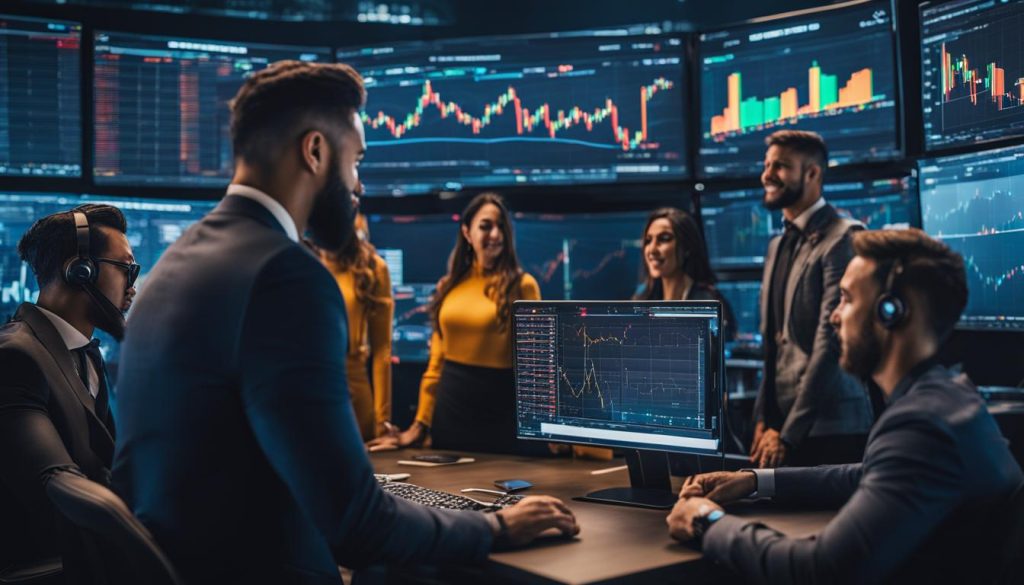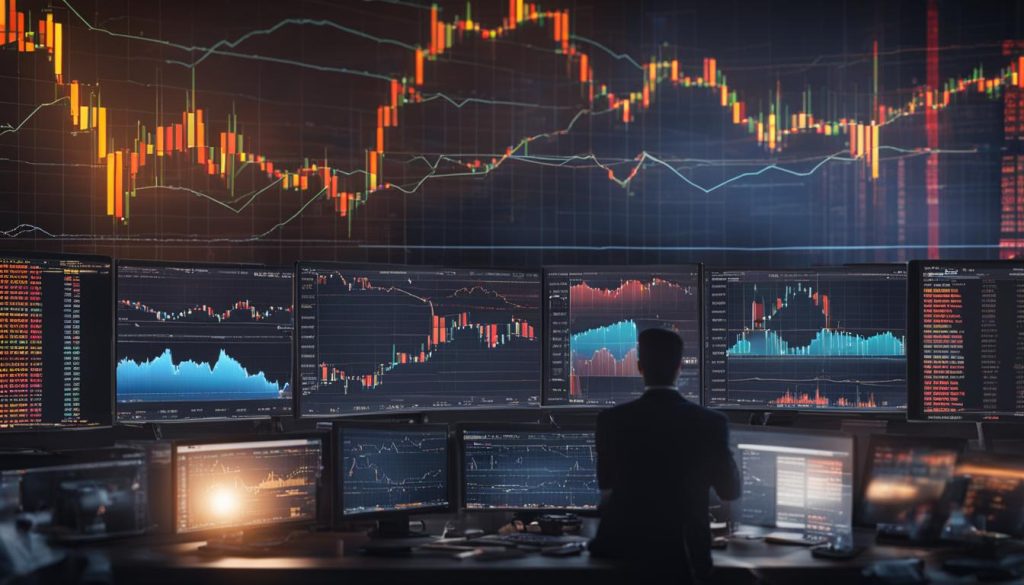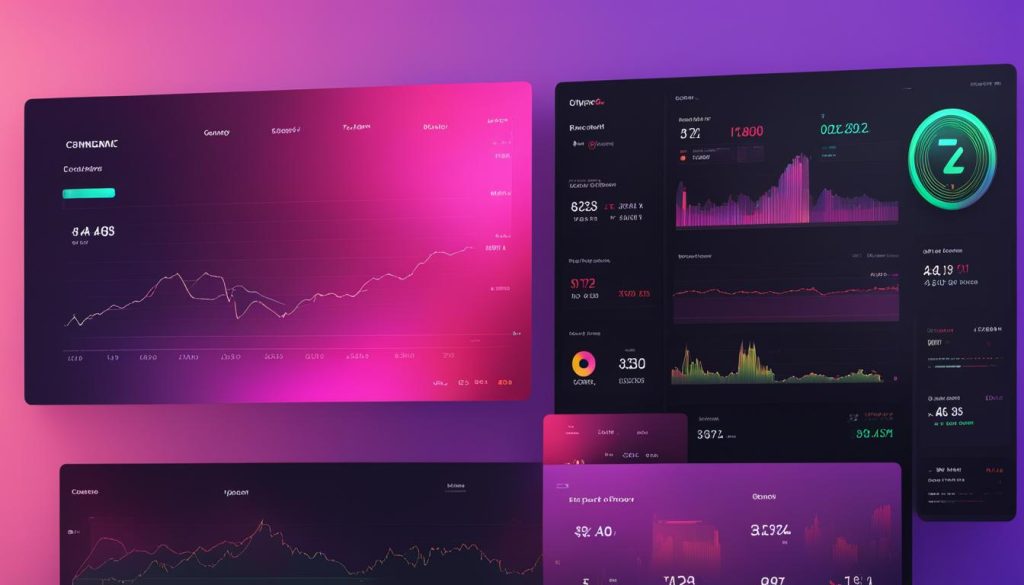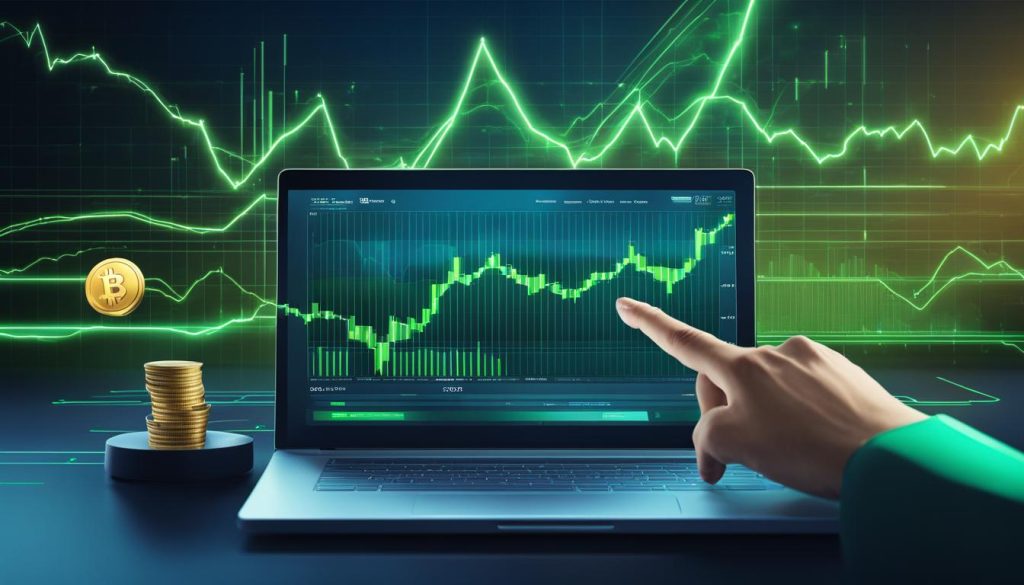Cryptocurrency-Margin trading offers opportunities for amplifying profits and navigating the digital asset market effectively. By leveraging crypto as collateral, traders can access higher trading power and diversify their trading strategies. This article explores the advantages of using crypto as collateral and highlights the benefits of the growing value of collateral, especially in bullish markets.
Key Takeaways:
- Cryptocurrency-Margin trading allows traders to amplify profits and navigate the digital asset market effectively.
- By using crypto as collateral, traders can access higher trading power and diversify their trading strategies.
- Margin trading offers advantages such as higher leverage, diversification of strategies, and exposure to different markets.
- Effective risk management is crucial in cryptocurrency margin trading to mitigate potential losses.
- Technical analysis and margin trading indicators can enhance trading performance and profitability.
Immediate Connect: How an App Can Help with Cryptocurrency Trading
When it comes to trading cryptocurrencies, having the right tools at your fingertips can make all the difference. That’s where Immediate Connect comes in. This innovative trading app is designed to help you navigate the exciting world of cryptocurrency trading with ease and efficiency.
Immediate Connect offers a user-friendly interface that makes trading a breeze. With its intuitive design, you can easily access your trading account and monitor your positions in real-time, all from the convenience of your mobile device. No more being tied to a desktop computer – with Immediate Connect, you have the freedom to trade on the go.
But it’s not just about convenience. Immediate Connect also provides advanced charting tools and real-time market data, empowering you to make informed trading decisions. Whether you’re a seasoned trader or just starting out, this app offers the tools and resources you need to stay ahead of the game.
“Immediate Connect is a game-changer for cryptocurrency traders. Its user-friendly interface and real-time market data make trading a breeze. I’ve been able to execute trades on the go and stay on top of market trends with ease. I highly recommend this app to anyone serious about trading cryptocurrencies.”
So why wait? Take your cryptocurrency trading to the next level with Immediate Connect. Download the app today and discover the difference it can make in your trading journey.

The Advantages of Cryptocurrency Margin Trading
Cryptocurrency margin trading provides several advantages. It allows you to access higher leverage, meaning you can control larger positions in the market with a fraction of the total value in your account. This can lead to potential higher profits when market conditions are favorable. Additionally, margin trading enables you to diversify your strategies and explore different markets and asset classes. By using crypto as collateral, you can gain exposure to traditional financial markets, commodities, or other cryptocurrencies.
One of the key advantages of crypto margin trading is the ability to amplify your trading power. By leveraging your crypto holdings, you can control larger positions and potentially multiply your profits. For example, if you have $1,000 worth of Bitcoin and use 10x leverage, you can control a $10,000 position in the market. This means that even small price movements can result in significant gains. However, it’s important to note that leverage also amplifies losses, so careful risk management is crucial.
Another advantage of margin trading is the opportunity to diversify your trading strategies. With traditional trading, you are limited to buying and selling assets with the capital you have. But with margin trading, you can use your crypto holdings as collateral to enter positions in various markets. For example, you can trade Bitcoin against the US dollar, or Ethereum against the Euro. This allows you to take advantage of different market trends and potentially increase your overall profitability. It also provides flexibility in adapting to changing market conditions.
In addition to diversification, margin trading with crypto collateral allows you to access other asset classes. Many margin trading platforms offer a wide range of trading pairs, including commodities, stocks, and other cryptocurrencies. This means you can trade not only within the crypto market but also in traditional financial markets. By expanding your trading opportunities, you can take advantage of different market cycles and potentially increase your overall returns.

Managing Risk in Cryptocurrency Margin Trading
When engaging in cryptocurrency margin trading, it is essential to implement effective risk management strategies to protect your investment. By understanding and managing the risks associated with margin trading, you can increase your chances of success and minimize potential losses.
One key aspect of risk management in margin trading is setting appropriate stop-loss levels. A stop-loss order is a predetermined price at which your position will be automatically closed to limit further losses. By setting a stop-loss order, you can mitigate the risk of significant losses in the event that the market moves against your position.
Diversifying your portfolio is another important risk management strategy. By spreading your investments across different cryptocurrencies or trading pairs, you can reduce the impact of any single asset’s performance on your overall portfolio. Diversification can help balance the potential risks and rewards of margin trading.
“Risk comes from not knowing what you’re doing.” – Warren Buffett
Monitoring margin requirements is crucial in managing risk in margin trading. Different cryptocurrencies and exchanges have varying margin requirements, which determine the amount of collateral you need to maintain in your account. Understanding and keeping track of these requirements will help you avoid margin calls and potential liquidation.
| Margin Trading Strategies for Cryptocurrencies | Risk Management Techniques |
|---|---|
| Diversify your portfolio | Set appropriate stop-loss levels |
| Stay informed about market trends and news | Monitor margin requirements |
| Utilize risk-reward analysis | Implement position sizing strategies |
By following these risk management strategies and continuously evaluating and adjusting your trading approach, you can navigate the volatility of cryptocurrency margin trading with greater confidence and increase your chances of success.

Margin Trading Indicators and Technical Analysis
When it comes to making informed trading decisions in cryptocurrency margin trading, understanding margin trading indicators and utilizing technical analysis can be instrumental in maximizing profitability. By leveraging these tools, traders can gain valuable insights into market trends and identify potential trading opportunities.
Margin Trading Indicators
Margin trading indicators provide traders with valuable information about the market dynamics and help them gauge the sentiment and direction of price movements. Some popular margin trading indicators for cryptocurrencies include:
- Moving Averages: Moving averages help identify trends by smoothing out price fluctuations over a specific period. Traders can use moving averages to identify support and resistance levels and determine potential entry and exit points.
- Relative Strength Index (RSI): The RSI is a momentum oscillator that measures the speed and change of price movements. It helps traders identify overbought or oversold conditions, indicating when an asset may be due for a reversal or correction.
- Bollinger Bands: Bollinger Bands consist of a moving average line and two standard deviation lines. They help traders identify periods of high or low volatility and potential price breakouts or reversals.
By combining these margin trading indicators and analyzing their signals, traders can gain a deeper understanding of market conditions and make more informed trading decisions.
Technical Analysis in Margin Trading
Technical analysis plays a crucial role in margin trading by analyzing historical price data and using various tools and indicators to predict future price movements. Traders can utilize chart patterns, trend lines, and candlestick patterns to identify potential entry and exit points, support and resistance levels, and trend reversals.
“Technical analysis is like a compass that guides traders through the complexities of margin trading, helping them navigate the market and make strategic decisions.”
However, it is essential to note that technical analysis is not foolproof and should be used in conjunction with other factors, such as fundamental analysis and market sentiment, to make well-rounded trading decisions.
| Margin Trading Indicators | Definition | Usage |
|---|---|---|
| Moving Averages | Smoothed out price line over a specific period | Identify trends, support and resistance levels |
| Relative Strength Index (RSI) | Momentum oscillator measuring overbought and oversold conditions | Identify potential reversals or corrections |
| Bollinger Bands | Consists of a moving average and two standard deviation lines | Identify volatility, price breakouts, or reversals |
By understanding margin trading indicators and utilizing technical analysis effectively, traders can enhance their trading performance and increase their chances of success in the dynamic world of cryptocurrency margin trading.

Marginal Trading Platforms for Cryptocurrencies
When engaging in cryptocurrency margin trading, it is crucial to choose a reputable and reliable trading platform that offers advanced features, security measures, and competitive fees. Here are some popular margin trading platforms for cryptocurrencies:
- Binance: Known as one of the largest cryptocurrency exchanges, Binance offers a margin trading platform that allows traders to access leverage and trade a wide range of cryptocurrencies.
- Kraken: Kraken is another well-established exchange that provides margin trading services. It offers a user-friendly interface and a variety of trading pairs.
- BitMEX: BitMEX is a platform specifically designed for leveraged trading. It offers high leverage options and advanced trading features, catering to experienced traders.
- Bybit: Bybit is a margin trading platform that focuses on perpetual contracts, providing traders with opportunities to profit from both rising and falling markets.
These platforms provide traders with access to leveraged trading opportunities and a wide range of trading pairs. It is important to consider factors such as liquidity, security, and customer support when choosing a platform to ensure a smooth trading experience.
“Choosing the right margin trading platform is essential for successful cryptocurrency trading. It is crucial to thoroughly research and compare different platforms to find the one that best suits your trading needs and preferences.”
Table: Comparison of Cryptocurrency Margin Trading Platforms
| Platform | Key Features | Leverage Options | Supported Cryptocurrencies |
|---|---|---|---|
| Binance | Advanced trading features, user-friendly interface | Up to 125x | Wide range of cryptocurrencies |
| Kraken | Well-established, variety of trading pairs | Up to 5x | Major cryptocurrencies |
| BitMEX | High leverage options, advanced trading features | Up to 100x | Bitcoin, Ethereum, others |
| Bybit | Focus on perpetual contracts, profit from rising and falling markets | Up to 100x | Bitcoin, Ethereum, others |
Each platform has its own unique features and strengths, so it’s important to choose the one that aligns with your trading goals and preferences. By selecting a reliable margin trading platform, you can confidently explore the world of cryptocurrency trading and unlock its potential for profitability.

Best Practices for Cryptocurrency Margin Trading
When engaging in cryptocurrency margin trading, it is important to follow best practices to maximize your success and minimize risks. Here are some proven strategies and tips to help you navigate the world of margin trading:
Develop a Solid Trading Plan
A well-defined trading plan is essential for margin trading. Determine your risk tolerance, set clear objectives, and establish rules for entry and exit points. Stick to your plan and avoid impulsive decisions driven by market fluctuations.
Set Clear Objectives
Set realistic profit targets and determine acceptable levels of loss. This helps you maintain discipline and avoid emotional trading decisions. Regularly evaluate your performance and adjust your objectives accordingly.
Use Appropriate Position Sizing
Proper position sizing is crucial in margin trading. Avoid overleveraging by carefully considering your account balance and risk tolerance. Determine the appropriate position size based on your strategy and the level of risk you are comfortable with.
Stay Informed
Keep up to date with market trends, news, and developments that can impact your trading decisions. Utilize reliable sources of information and leverage technical analysis tools to identify potential trading opportunities.
- Follow reputable cryptocurrency news platforms and social media accounts.
- Monitor market indicators and key price levels.
- Stay informed about regulatory changes and industry developments.
Utilize Stop-Loss Orders
Implementing stop-loss orders is crucial for managing risk in margin trading. Set stop-loss orders to automatically close your positions if the market moves against you beyond a predetermined level. This helps protect your capital and minimizes potential losses.
“The key to successful margin trading is to balance risk and reward while sticking to a well-defined trading plan. By following these best practices, you can increase your chances of achieving consistent profitability in cryptocurrency margin trading.”
Remember, margin trading involves significant risks, and it is important to exercise caution and employ proper risk management strategies. By following these best practices and continuously educating yourself, you can enhance your margin trading skills and potentially capitalize on profitable opportunities in the cryptocurrency market.
Margin Requirements in Cryptocurrency Trading
When engaging in cryptocurrency margin trading, it is important to understand the concept of margin requirements. Margin requirements refer to the amount of collateral that traders must maintain in their trading accounts to support their leveraged positions. Different cryptocurrency exchanges and platforms have varying margin requirements, which usually depend on the trading pair and the level of leverage used.
By setting margin requirements, exchanges aim to ensure that traders have enough collateral to cover potential losses and protect both the trader and the platform. These requirements act as a safety net to mitigate the risk of margin calls or liquidation of positions. Understanding and adhering to margin requirements is crucial as failure to meet the minimum collateral threshold can lead to forced liquidation of positions and potential loss of funds.
It is also important to be aware of the associated costs of margin trading, such as margin interest rates. Margin interest rates are the fees charged by exchanges or lending platforms for borrowing funds to trade on margin. These rates can vary and may depend on factors such as the loan amount, duration, and the interest rate market. Traders should carefully consider these costs and factor them into their trading strategies to ensure they can effectively manage their trades and potential expenses.
| Exchange | Margin Requirement | Margin Interest Rate |
|---|---|---|
| Binance | 10% | Varies |
| Kraken | 20% | Varies |
| BitMEX | 1% | Varies |
| Bybit | 5% | Varies |
Table: Margin requirements and interest rates for selected cryptocurrency exchanges.
It is important for traders to carefully read and understand the terms and conditions set by each exchange or lending platform regarding margin requirements and interest rates. This will ensure that they are well-informed and can effectively manage their margin trading activities while considering the costs and potential risks involved.
Margin Liquidation in Cryptocurrency Trading
Margin liquidation is a crucial aspect of cryptocurrency trading that traders must understand to protect their investments and manage risk effectively. When engaging in margin trading, it is essential to be aware of the possibility of margin liquidation and take appropriate measures to mitigate its impact on your trading positions.
Margin liquidation occurs when the account value falls below the required maintenance margin, resulting in the automatic closure of your positions. This happens to prevent further losses and ensure the account has sufficient collateral to cover the borrowed funds.
“Margin liquidation can lead to significant losses if not properly managed. It is crucial to set appropriate stop-loss orders and actively monitor your margin level to avoid potential liquidation.”
To prevent margin liquidation, it is advisable to set stop-loss orders strategically. A stop-loss order is a predetermined price level at which your position is automatically closed to limit potential losses. By setting stop-loss orders based on your risk tolerance and market analysis, you can protect your capital and reduce the likelihood of margin liquidation.
Additionally, closely monitoring your account’s margin level and evaluating your risk exposure regularly are essential risk management practices. It is crucial to understand the dynamics of margin trading and adjust your positions accordingly, considering factors such as market volatility, leverage used, and potential price fluctuations.
Table: Steps to Prevent Margin Liquidation
| Steps | Description |
|---|---|
| Set appropriate stop-loss orders | Set predetermined price levels at which your positions are automatically closed to limit potential losses. |
| Monitor account’s margin level | Closely monitor your account’s margin level to ensure it remains above the required maintenance margin. |
| Evaluate risk exposure regularly | Continually assess your risk exposure and adjust your positions based on market conditions, volatility, and potential price fluctuations. |
Margin Trading and Price Volatility
Margin trading has a significant impact on price volatility in the cryptocurrency market. When traders use leverage to amplify their positions, it can lead to increased buying or selling pressure, causing prices to fluctuate more rapidly. The ability to trade on margin allows investors to take larger positions than they would be able to with their available capital. This increased trading power can result in exaggerated price movements, both to the upside and downside.
However, it’s important to note that margin trading itself doesn’t directly cause price volatility. It is the collective actions of traders taking leveraged positions that contribute to market movements. In a bullish market, as traders buy more on margin, demand increases, pushing prices higher. Conversely, in a bearish market, as traders sell short on margin, supply increases, pushing prices lower.
When engaging in margin trading, it is crucial to carefully consider the risk-reward ratio. While leverage can amplify potential profits, it also magnifies potential losses. Traders must evaluate the potential gains against the potential risks before entering a leveraged position. It is advisable to set appropriate stop-loss orders and continually monitor positions to mitigate the impact of price volatility.
| Pros of Margin Trading | Cons of Margin Trading |
|---|---|
|
|
While margin trading can be a lucrative strategy, it requires careful risk management and a thorough understanding of market dynamics. Traders should assess their risk tolerance, set realistic profit targets, and implement appropriate position sizing strategies. By considering the impact of margin trading on price volatility and maintaining a disciplined approach, traders can navigate the challenges and potentially benefit from the opportunities presented by margin trading.
Long and Short Positions in Crypto Margin Trading
In crypto margin trading, understanding the dynamics of long and short positions is crucial to making informed trading decisions. By comprehending these two concepts and implementing appropriate position sizing strategies, traders can optimize their margin trading positions.
Long Positions
When taking a long position, traders buy an asset with the expectation that its price will increase. This bullish stance allows traders to profit from an uptrend in the market. By leveraging crypto as collateral, traders can amplify their buying power and potentially achieve higher returns. However, it is essential to carefully assess market conditions, conduct thorough research, and use risk management techniques to mitigate potential losses.
Short Positions
Conversely, short positions involve selling an asset with the anticipation that its price will decrease. Traders who take short positions aim to profit from a bearish market or declining prices. By borrowing assets and selling them at a higher price, traders can later repurchase the assets at a lower price, pocketing the difference as profit. Short positions can provide opportunities for traders to benefit from market downturns, hedge against potential losses, and diversify their trading strategies.
It is important to note that margin trading, whether long or short, carries inherent risks. Traders should exercise caution, conduct thorough analysis, and manage their positions effectively to minimize potential losses and maximize profit potential in the dynamic world of cryptocurrency margin trading.

Conclusion
In conclusion, cryptocurrency margin trading presents a significant profit potential for traders. By leveraging crypto as collateral, you gain access to higher trading power, allowing you to control larger positions in the market and potentially amplify your profits. However, it’s important to remember that margin trading also carries risks.
Managing risk is crucial in margin trading, and understanding the risk-reward ratio is essential. By carefully evaluating potential risks and rewards, you can make informed trading decisions and protect your capital. Implementing risk management strategies, such as setting appropriate stop-loss levels and diversifying your portfolio, can help mitigate potential losses.
In addition, understanding the dynamics of long and short positions is key to optimizing your margin trading. Long positions involve buying assets with the expectation of price increases, while short positions involve selling assets with the expectation of price decreases. By employing appropriate position sizing strategies and utilizing risk management techniques, you can optimize your margin trading positions.
In summary, while cryptocurrency margin trading offers profit potential, it’s crucial to approach it with caution. By understanding the risk-reward ratio, managing risk effectively, and using appropriate position sizing strategies, you can navigate the world of margin trading and unlock its potential for enhanced profitability.
FAQ
What is cryptocurrency margin trading?
Cryptocurrency margin trading allows traders to borrow funds to amplify their trading power and access higher leverage, enabling them to control larger positions in the market with a fraction of the total value in their accounts.
What are the advantages of cryptocurrency margin trading?
Cryptocurrency margin trading offers higher profit potential, the ability to diversify trading strategies, and access to traditional financial markets, commodities, and other cryptocurrencies.
How can I manage risk in cryptocurrency margin trading?
Effective risk management in cryptocurrency margin trading involves setting appropriate stop-loss levels, diversifying your portfolio, monitoring margin requirements, and understanding the potential risks associated with leverage.
What role does technical analysis play in cryptocurrency margin trading?
Technical analysis helps traders make informed trading decisions by utilizing indicators such as moving averages, relative strength index (RSI), and Bollinger Bands to analyze market trends and identify potential trading opportunities.
What are some popular cryptocurrency margin trading platforms?
Some popular cryptocurrency margin trading platforms include Binance, Kraken, BitMEX, and Bybit. It is important to choose a reputable and reliable platform that offers advanced trading features, security measures, and competitive fees.
What are some best practices for cryptocurrency margin trading?
Best practices for cryptocurrency margin trading include developing a solid trading plan, setting clear objectives, using appropriate position sizing, staying informed about market trends, utilizing stop-loss orders, and continually evaluating and adjusting strategies based on market conditions.
What are margin requirements in cryptocurrency trading?
Margin requirements refer to the amount of collateral traders need to maintain in their accounts to support their leveraged positions. Different cryptocurrency exchanges and platforms have varying margin requirements based on trading pairs and leverage levels.
What is margin liquidation in cryptocurrency trading?
Margin liquidation occurs when a trader’s account value falls below the required maintenance margin, leading to the automatic closure of their positions. To prevent margin liquidation, traders can set appropriate stop-loss orders, monitor their account’s margin level, and implement risk management practices.
How does margin trading impact price volatility in the cryptocurrency market?
Margin trading can contribute to increased price volatility as leverage amplifies both potential profits and losses. Traders should consider the risk-reward ratio, carefully manage their positions, and implement risk management techniques to mitigate extreme price fluctuations.
What are long and short positions in crypto margin trading?
In crypto margin trading, long positions involve buying an asset with the expectation that its price will increase, while short positions involve selling an asset with the expectation that its price will decrease. Traders should understand the dynamics of long and short positions, implement appropriate position sizing strategies, and employ risk management techniques.

